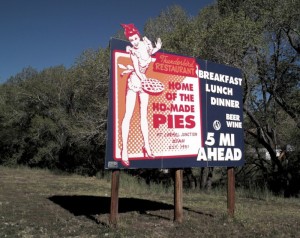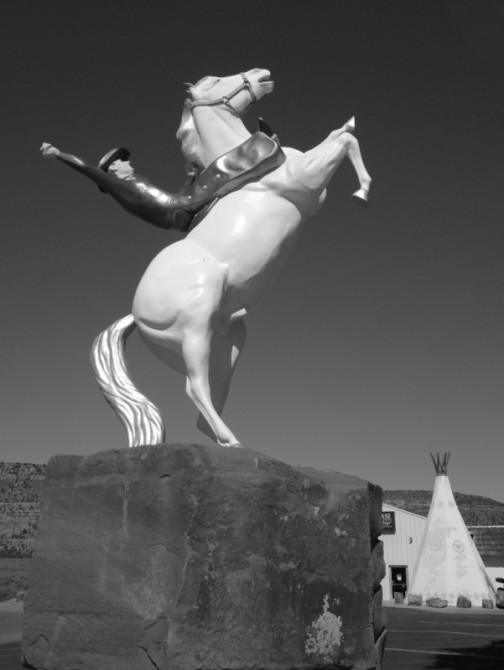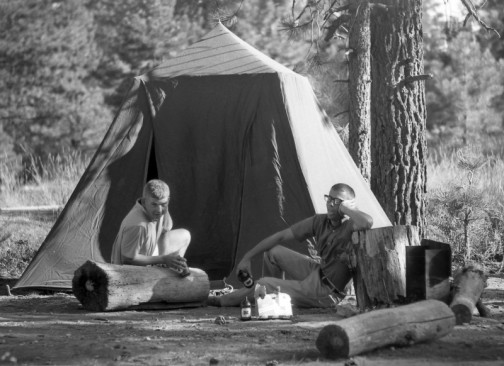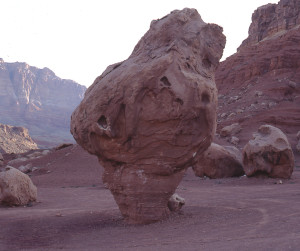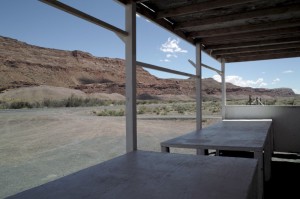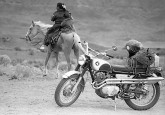COWBOYS AND INDIANS
Overnight, the motel parking lot has accumulated four additional motorcycles, all of them BMW enduros. Three bear Idaho plates, the fourth is from Quebec. Its panniers are plastered with multiple stickers including one from Patagonia—the holy grail of long distance motorcycle touring! Who among us hasn’t dreamt of riding his bike all the way to Tierra de Fuego? I know I have. It’s long been on my bucket list—but first, I’ve got to find my way across Arizona.
After making sure no one is watching, I make a balletic leap onto the saddle of my Beemer and continue south on U.S. 89. By and by, I sense a cultural shift. I pass a multitude of roadside rock stands and curio shops and billboards bearing words one doesn’t normally see in Utah, such as COLD BEER. Approaching Mount Carmel Junction, I spot a billboard advertising “Ho-made” pies. Unbelievable!
Then there’s the Hollywood vibe. Turns out many a Western has been filmed in the red rock canyons surrounding Kanab. Tour buses filled with foreign tourists stop there, resulting in a lively trade in cowboy hats and Indian jewelry. Mock gunfights and hangings occur at regular intervals. I see my first concrete teepee.
At an intersection halfway through town I make an impulsive decision. 89A heads directly south and looks to be a shortcut to the Arizona state line, so I take it. I soon have the road pretty much to myself, probably because the north rim of the Grand Canyon is still closed for the season. At Jacob’s Lake I hang a left and continue in a northeasterly direction all the way back to 89, which is anything but a shortcut to my destination: Clark Hunt’s house in Sierra Vista outside the U.S. Army base of Fort Huachuca.
Clark Hunt is a boyhood friend. The two of us grew up in Price, Utah, attended the same schools, went to the same church, played in the same marching band and even labored in the same tire recapping sweatshop. In the summer of 1964, shortly after I received my first Dear John letter, Clark and I embarked on a camping trip to Southern Utah, where he introduced me to the joys of Lucky Lager. It was the first time I’d ever tasted beer, so I suppose it could be said that camping trip was a turning point in my life. Looking back, I shudder to think what might have become of me, had I not gotten dumped by a certain BYU coed—a rejection which led to the camping trip and my first taste of beer and culminated with me trading in my Honda 50 for a bigger, faster motorbike.
On a motorcycle, you don’t just see everything, you also smell everything, and the piney scent of the Kaibab plateau takes me back not just to that 1964 camping trip but even further—to family vacations in the Fifties to Yellowstone, Oregon, Washington, and Los Alamos, New Mexico. I love the smell, and I’m content to glide along noiselessly like a spotted owl beneath a fragrant Ponderosa canopy. Alas, it doesn’t last long. I pass a sign informing me I’m about to leave the national forest. Then the highway descends abruptly through three or four life zones before bottoming out on the Navajo reservation.
Here’s the thing about Indians: they don’t require much in the way of creature comforts. They are native to the Southwest and not at all afraid of wide open spaces. Hydration? Navajos don’t require hydration. Shade? If you can’t take the heat, go back to Europe, paleface!
For the next several miles the only shade I see is a small shadow cast by a precariously balanced rock. Then comes into view a roadside vending stand—the first of many on the reservation. Slapdash structures constructed of two-by-fours and four-by-eight-foot sheets of wafer board, most were unoccupied. The occupied stands feature native entrepreneurs peddling rugs, jewelry and pottery. I pass one stand with a table display that includes not just rugs, jewelry and pottery, but also one heat-stricken motorcyclist.
Wisely, I had packed a couple of bottles of water—one of which I pour into my boots, which are beginning to roast my feet. The other I pour into my helmet. I open my jacket to the wind and curse the fact I‘m still wearing the long johns I’d donned that morning before setting out from chilly Panguitch.
Back in 1968, my route had included much more Indian land; in fact, I’d even made a side trip into Monument Valley. I must have been a lot tougher back then. Even so, I remember that when I finally got to Flagstaff, I decided to open my wallet and let the moths fly out. The off-season rate for my motel room for the night—I distinctly remember—was two dollars and fifty cents.
Half a century later, Flagstaff has grown so much I hardly recognize it. As a result, I get lost and miss a turn that would have taken me back into the blessed high country of the Coconino National Forest. Instead, I wind up on 89A, which descends through Oak Canyon via a series of spectacular switchbacks to beautiful (and pricey!) Sedona. The streets of Sedona are aswarm with tourists wearing cargo shorts, Capri pants, flip flops and halter tops. I pass numerous outdoor cafes, brewpubs and outdoor outfitters, boutiques and art galleries, New Age meditation centers, magic crystal emporia—even a portrait studio specializing in “aura photos.”
Northern Arizona is in the grip of an early season heat wave, and what with my long underwear and multiple layers of clothing, I can well imagine I’m emitting quite an aura. I can’t wait to shed my riding gear, but press on valiantly until finally I’m clear of what looks to be the high rent district. Still, a room in Kokopelli sets me back a hundred bucks. Quite a jump from two dollars and fifty cents—but on the bright side, my room is cool and commands a nice view. Of a swimming pool.
